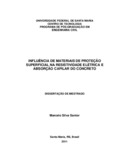| dc.creator | Santor, Marcelo Silva | |
| dc.date.accessioned | 2011-10-21 | |
| dc.date.available | 2011-10-21 | |
| dc.date.issued | 2011-01-24 | |
| dc.identifier.citation | SANTOR, Marcelo Silva. INFLUENCE OF SUPERFICIAL PROTECTION MATERIALS IN
ELECTRICAL RESISTIVITY AND CAPILLARY ABSORPTION OF CONCRETE. 2011. 104 f. Dissertação (Mestrado em Engenharia Civil) - Universidade Federal de Santa Maria, Santa Maria, 2011. | por |
| dc.identifier.uri | http://repositorio.ufsm.br/handle/1/7762 | |
| dc.description.abstract | The durability of concrete structures is the result of protective action of concrete over the rebar. When the passivation of steel ceases to exist the structure
becomes vulnerable to the phenomenon of corrosion, which spread after start is largely controlled by the electrical resistivity of concrete. Another important factor in
the durability of concrete structures is the absorption, which is one of the properties governing the transport of ions inside the concrete. This study aimed to evaluate the
electrical resistivity and capillary absorption of concrete that have undergone surface treatment: a monolithic polymeric mortar applied in a layer of 4mm, and a pore blocker with a single coat and a pore blocker with a double coat. The concrete surface subjected to treatment were made with three types of cement,CP IV-32, CP
II-F 32 and CP V and levels of compressive strength of 15MPa, 20MPa and 25MPa. The electrical resistivity was measured by the method of four electrodes and capillary
absorption by the method NBR 9779. Treatment with the pore blocker with a double coat was more effective in reducing capillary absorption than a pore blocker with a single coat for the three types of cement, but the best results were obtained using the polymer mortar. In this work the pozzolanic effect present on cement CP IV became more clear in the result of electrical resistivity for all treatment studied. The different behavior of the electrical resistivity of concrete with cement CP IV in relation to others, CPII F and CP V, is justified by changes in the microstructure of the paste, pore refinement and composition of pore solution. In addition to this, when compared to concrete made with CP V, the lower relations/binder of CP IV to obtain the compressive strengh levels investigated, fck = 15 Mpa , 20Mpa and 25Mpa. Even the reference concrete without surface treatment showed values of resistivity well above
the actual reference compounds with CP II-F and CP V and also subjected to surface treatment. | eng |
| dc.description.sponsorship | Coordenação de Aperfeiçoamento de Pessoal de Nível Superior | |
| dc.format | application/pdf | por |
| dc.language | por | por |
| dc.publisher | Universidade Federal de Santa Maria | por |
| dc.rights | Acesso Aberto | por |
| dc.subject | Concreto | por |
| dc.subject | Resistividade elétrica | por |
| dc.subject | Absorção capilar | por |
| dc.subject | Tratamento superficial | por |
| dc.subject | Concrete | eng |
| dc.subject | Electrical resistivity | eng |
| dc.subject | Capillary absorption | eng |
| dc.subject | Surface treatment | eng |
| dc.title | Influência de materiais de proteção superficial na resistividade elétrica e absorção capilar do concreto | por |
| dc.title.alternative | Influence of superficial protection materials in electrical resistivity and capillary absorption of concrete | eng |
| dc.type | Dissertação | por |
| dc.description.resumo | A durabilidade das estruturas de concreto armado é resultado da ação protetora do concreto sobre a armadura. Quando a passivação do aço deixa de existir a estrutura torna-se vulnerável ao fenômeno da corrosão, cuja propagação,
após iniciada é essencialmente controlada pela resistividade elétrica do concreto. Outro fator importante na durabilidade das estruturas do concreto é a absorção capilar, a qual é uma das propriedades que regem o transporte de íons no interior do
concreto. O presente estudo teve por objetivo avaliar a resistividade elétrica e a absorção capilar em concretos que foram submetidos a tratamento superficial: uma argamassa polimérica monocomponente aplicada em camada de 4mm, e um produto obturador dos poros aplicado em uma e duas demãos. Os concretos submetidos ao tratamento superficial foram produzidos com três tipos de cimento, CP IV 32, CP II F 32 e CP V, e para os níveis de resistência à compressão de
15MPa, 20MPa e 25MPa. A resistividade elétrica foi medida pelo método dos quatros eletrodos e a absorção capilar segundo o método NBR 9779. O tratamento com o produto obturador dos poros em dupla demão mostrou-se mais efetivo na redução da absorção capilar do que o tratamento com uma demão para os três tipos de cimento, contudo, os melhores resultados foram obtidos com o uso da argamassa polimérica. Neste trabalho o efeito pozolânico presente no cimento CP IV ficou claro nos resultados de resistividade elétrica para todos os tratamentos estudados. Este comportamento diferenciado do CP IV em relação aos demais, CP II F e CP V, se
justifica pelas alterações na microestrutura da pasta, refinamento dos poros e composição da solução dos poros. Acresce a isto, quando comparado aos concretos
produzidos com CP V, as menores relações a/agl do CP IV para obtenção dos níveis de resistência à compressão investigados. Mesmo o concreto de referência sem
tratamento superficial apresentou valores de resistividade elétrica muito superiores aos concretos de referência compostos com CP II F e CP V e também submetidos a
tratamento superficial. | por |
| dc.contributor.advisor1 | Gastaldini, Antonio Luiz Guerra | |
| dc.contributor.advisor1Lattes | http://lattes.cnpq.br/9293085240832049 | por |
| dc.contributor.referee1 | Cervo, Tatiana Cureau | |
| dc.contributor.referee1Lattes | http://lattes.cnpq.br/8942097635550980 | por |
| dc.contributor.referee2 | Mohamad, Gihad | |
| dc.contributor.referee2Lattes | http://lattes.cnpq.br/5446970753192990 | por |
| dc.creator.Lattes | http://lattes.cnpq.br/3602713804582810 | por |
| dc.publisher.country | BR | por |
| dc.publisher.department | Engenharia Civil | por |
| dc.publisher.initials | UFSM | por |
| dc.publisher.program | Programa de Pós-Graduação em Engenharia Civil | por |
| dc.subject.cnpq | CNPQ::ENGENHARIAS::ENGENHARIA CIVIL | por |


